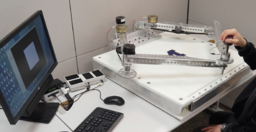Semi-Passive Rehabilitation Robot for Functional Resistance Training of the Upper-Extremity
TECHNOLOGY NUMBER: 7629

OVERVIEW
Semi-passive rehabilitation robot for in-home upper extremity rehabilitation/therapy- Combines benefits of assistive robots and passive training such as with weights or bands
- A device which provides real time feedback regarding feedback to the patient
BACKGROUND
At home robotic rehabilitation offers potential benefits for patients with neurological or orthopedic disorders. This approach may also prove useful for patients recovering after an injury or following surgery. However, since most assistive devices actively perform movements for the patient or force movement along a predefined path, incorrect programming could compromise the safety of the patient. Additionally, active robotic devices require several large motors, making the equipment bulky and expensive. Furthermore, if the patient has regained some functioning or has progressed sufficiently well through their therapy course, assistive therapy may prove suboptimal for this phase of recovery. While patients in this portion of their rehabilitation may rely on elastic bands or hand weights, the path of movement is not controllable with these forms of passive equipment. A need exists for a rehabilitation robot that provides a safer and more versatile user experience.
INNOVATION
Researchers at the University of Michigan have created a semi-passive robot (SepaRRo) which can provide safe, low-cost, in-home rehabilitation therapy for patients suffering from neurological or orthopedic disorders. The SepaRRo combines the benefits of assistive robots and traditional exercise equipment in a single, compact device. Rather than moving the arm for the patient, this technology allows users to program their desired path and resistance to then move a handle along the desired path with assistive steering technology. The user can adjust the desired resistance and receive real-time biofeedback while tracking progress over time.
Experiments in a healthy human subject have shown that SepaRRo is capable of targeting specific muscle groups, therefore providing ideal rehabilitation for patients with muscle imbalances. SepaRRo’s design enables a broad range of resistive forces which can therefore help to steer the movement of the limb along the desired path. The use of passive braking rather than active motors helps decrease its expense and weight. This invention offers a meaningful solution for patients with a wide variety of illnesses that require rehabilitation.